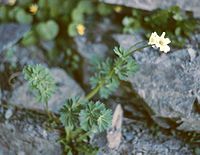Puccinia callianthemi
| Puccinia callianthemi | ||||||||||||
|---|---|---|---|---|---|---|---|---|---|---|---|---|
| Systematics | ||||||||||||
|
||||||||||||
| Scientific name | ||||||||||||
| Puccinia callianthemi | ||||||||||||
| Gäumann |
Puccinia callianthemi is a stand fungal art from the order of the rust fungi (Pucciniales). The fungus is an endoparasite of the coriander leaf ornamental flower . Symptoms of infestation by the species are yellow spots of rust and pustules on the leaf surfaces of the host plants. The distribution area is in the western Alpine region .
features
Puccinia callianthemi can only be recognized with the naked eye by means of the spore beds protruding on the surface of the host. They grow in nests that appear as yellowish to brown or blackish spots and pustules on the leaf surfaces.
The mycelium of Puccinia callianthemi grows as with all Puccinia TYPES intercellular and forms Saugfäden that grow into the storage tissue of the host. The parts of the species are small, rounded and connected to larger groups, about 3–4 cm in diameter. They are gray-brown in color. The teleutospores are variable, mostly club-like, two-celled and 45–56 × 13–18 µm in size. They are colorless to brownish, their stem is very short. Pycnien , Uredien and Aecien are not trained.
distribution
Puccinia callianthemi has a distribution area that extends over the Valais Alps .
ecology
The host plant of Puccinia callianthemi is the coriander- leaved ornamental flower ( Callianthemum coriandrifolium ) from the genus of ornamental flowers ( Callianthemum ). The fungus feeds on the nutrients present in the storage tissue of the plants, its spore beds later break through the leaf surface and release spores. The species has a development cycle that shows only parts and does not need to change hosts.
literature
- Ernst Gäumann: The rust fungi of Central Europe. With special consideration of Switzerland . In: Contributions to the cryptogam flora in Switzerland . tape XII . Commission publisher Buchdruckerei Büchler & Co, Bern 1959.
